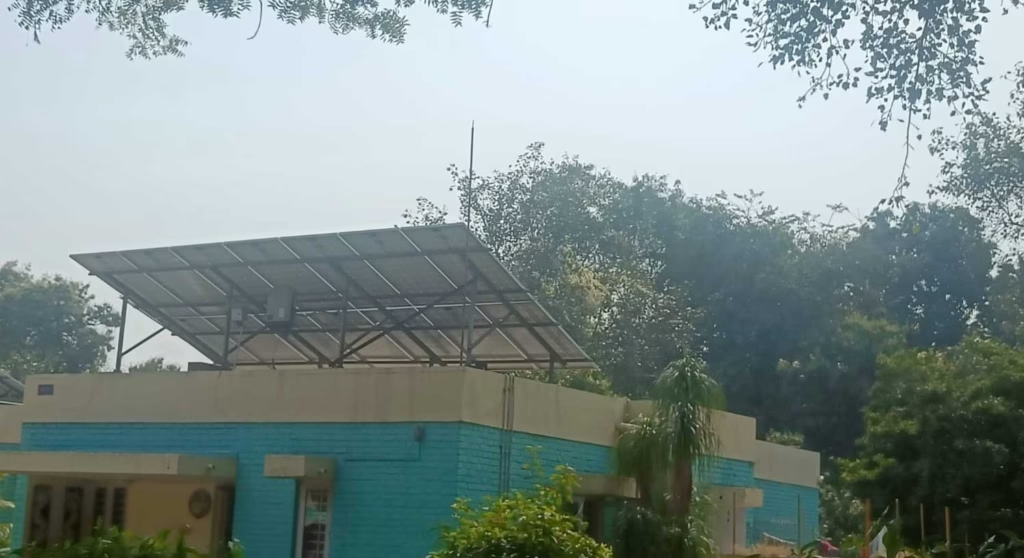Earth
How IIT Kanpur is Paving the Way for a Solar-Powered Future in India’s Energy Transition
At IIT Kanpur, an ambitious solar energy project is reshaping the way India approaches renewable energy. By integrating solar power with smart grids and energy storage, the project aims to make communities more energy-independent and sustainable

The narrow roads within IIT Kanpur’s campus wind through a vibrant residential neighbourhood, where compact, beautifully designed homes house the staff. Above these homes, solar panels gleam in the sunlight—not merely as an aesthetic feature, but as a symbol of a much larger energy transformation underway. This gleam reflects a bold vision for India’s energy future, one that’s driven by solar power, smart technology, and community participation.
At the heart of this transformation is IIT Kanpur, located in India’s Uttar Pradesh, lighting the way toward an energy future powered by clean, renewable energy. With innovation as its cornerstone, IIT Kanpur is shaping a new model of energy independence for India—a model that could be replicated across the country.
The spark of change
In 2017, the Indo-US partnership, known as the US-India Collaborative for Smart Distribution System with Storage (UI-ASSIST), was launched, bringing together top institutions from both countries. Led by Washington State University in the U.S. and IIT Kanpur in India, the partnership also includes IIT Delhi, IIT Madras, IIT Roorkee, IIT Bhubaneswar, and TERI (The Energy and Resources Institute). Their collective goal: to create scalable, sustainable solutions for integrating renewable energy into India’s power grid. “This new consortium demonstrates the U.S. and India’s commitment to ensuring access to affordable and reliable energy in both countries,” said then-U.S. Energy Secretary Rick Perry. “We know that continued grid innovation will foster economic growth and enhance energy security in both the United States and India.”
IIT Kanpur’s residential area has become a testing ground for this vision. Out of the 51 homes in residential lanes 32 and 33, 30 houses were selected based on a shadow analysis survey. These homes have been equipped with 5kWp Solar Photovoltaic (PV) systems and state-of-the-art smart meters, turning residents into active energy producers. This transformation was part of a larger vision to create a microgrid capable of providing energy independence to the community.

A model of solar empowerment
Imagine this: families, once entirely dependent on the grid, now waking up to homes powered by the sun. “In Lane 32, 12 of the 21 homes are now powered by solar energy, while 18 out of 30 homes in Lane 33 have solar PV installations,” says Shiv Kumar Singh, Research Establishment Officer at IIT Kanpur’s Department of Electrical Engineering.

These homes are no longer passive consumers. With 5 kW of solar capacity, they actively contribute to the energy network, providing power to the grid and helping to reduce the community’s overall carbon footprint. For IIT Kanpur, this project is more than just an experiment—it’s a proof of concept for how solar energy can be scaled beyond cities and industries and into residential communities.
The hidden power: Energy storage and control
At the core of this experiment lies a powerful duo: energy storage and smart management. According to Shiv Kumar Singh, the project integrates two centralized lithium-ion battery storage systems—one with a 140 kWh capacity and another with 100 kWh. These systems store excess solar energy generated during the day and return it to the grid during the evening, when the sun sets.
But it doesn’t stop there. The project is made even smarter by the use of data. Smart meters, installed throughout the system, constantly collect data on energy consumption. This data is fed into a SCADA control center, where it’s analyzed in real-time to optimize energy usage and ensure the grid operates as efficiently as possible. This intelligent, data-driven approach maximizes every watt of energy generated and consumed.

Driving the future of clean transportation
As solar energy begins to power homes, another puzzle piece is being put in place: clean transportation. At IIT Kanpur, two new electric vehicle (EV) charging stations have been set up near the main gate and the nearby Community Centre. These stations are equipped with a variety of chargers, including 50kW DC fast chargers, 22kW AC chargers, and 7.6kW Vehicle-to-Home (V2H) chargers, integrated with a 25kW solar PV array.
This isn’t just about charging vehicles; it’s about creating a self-sustaining ecosystem where transportation and energy generation are interconnected. By using clean energy to charge electric vehicles, IIT Kanpur is contributing to a future where urban mobility is powered by renewable resources, significantly reducing the carbon footprint of transportation.
Smart and sustainable: The microgrid revolution
The centerpiece of this entire initiative is the microgrid, which is controlled and optimized by a sophisticated Microgrid Controller. This technology ensures that energy is distributed efficiently among solar PV systems, storage units, and EV charging stations, keeping everything balanced and functioning smoothly. Thanks to real-time data analysis from the smart meters and SCADA center, the system isn’t just reactive—it’s proactive, learning from its environment and optimizing energy use as it goes.
Urban field demonstration pilot at IIT Kanpur
With growing urban energy demands, India faces a unique set of challenges. Multi-story buildings, high air-conditioning loads, and reliance on Diesel Generators (DGs) for backup power add significant strain to the grid and contribute to pollution. IIT Kanpur is tackling these issues head-on with two groundbreaking sub-pilots that demonstrate innovative energy solutions.

The first sub-pilot features a small, grid-connected microgrid designed to supply energy to two multi-story residential towers. By integrating Solar PV systems and Battery Energy Storage Systems (BESS), this project reduces the reliance on DGs and provides a more sustainable, reliable energy source. During power outages, BESS ensures uninterrupted power for essential services, such as lifts and lighting in common areas.
The second sub-pilot showcases the potential of Thermal Energy Storage (TES) system, which, inaugurated in November 2020, help reduce peak air-conditioning loads. By storing cool energy during off-peak hours, TES systems cut energy consumption during peak demand times. This system has already been installed at IIT Kanpur’s Centre for Environmental Science and Engineering, where a 775 TRHR TES system is actively reducing air-conditioning loads, further enhancing energy efficiency.
The environmental impact
IIT Kanpur’s approach goes beyond technology; it’s about creating lasting environmental and social benefits. By integrating TES and solar PV systems, the initiative not only reduces peak load but also cuts carbon emissions, contributing to India’s carbon-neutral goals. The integration of BESS ensures that the urban microgrid remains reliable even during power outages, helping foster long-term sustainability.
The 775 TRHR TES system at the Centre for Environmental Science and Engineering plays a key role in reducing the building’s air-conditioning demand. By using phase change materials with glycol solution as the coolant, it absorbs off-peak energy to cool the building during peak periods, leading to significant energy savings.
According to a research paper (2022) by Suresh Chandra Srivastava, Sameer Khandekar, Shiv Kumar Singh, Vinay Kumar Tiwari, and Ankush Sharma from IIT Kanpur, this system has led to a reduction in peak load energy consumption, as verified through data recorded by the SCADA system monitoring the Institute’s power distribution network. By discharging during peak hours and charging during off-peak hours, the system helps reduce peak load and offers potential cost savings, as electricity costs are higher during peak times.

This technology has the potential for widespread adoption in smart cities and data centers across India, further advancing the country’s renewable energy vision.
Shaping India’s renewable energy future
India’s goal of achieving 500 GW of renewable energy capacity by 2030, with a significant portion coming from solar, is ambitious but increasingly attainable with projects like IIT Kanpur’s. With nearly 40% of solar PV installations expected to be on rooftops connected to the distribution network, initiatives like this one are essential for meeting the country’s renewable energy targets.
By demonstrating how solar energy, energy storage, and sustainable infrastructure can be integrated at the community level, IIT Kanpur is not just building a model for India—it’s creating a blueprint for the world. As the world shifts towards a cleaner, more sustainable future, IIT Kanpur is leading the way.
(This story is produced as part of the Internews Earth Journalism Network’s Science Communicators Workshop on renewable energy)
COP30
Over 832,000 Lives Lost, $4.5 Trillion in Damages, Extreme Weather The “New Normal”: Warns Climate Risk Index
A new report reveals the staggering toll of extreme weather — over 832,000 deaths and $4.5 trillion in losses between 1995 and 2024.

The numbers are stark, and the story they tell is even starker. More than 832,000 people have lost their lives and USD 4.5 trillion in direct economic losses have been recorded worldwide as a result of nearly 9,700 extreme weather events over the past three decades. That is the central finding of the Climate Risk Index (CRI) 2026, released by the environmental think tank Germanwatch at COP30 in Belém, Brazil.
The new report — the most comprehensive edition of the CRI to date — presents what its authors describe as a “mirror to global injustice”: a world where the poorest nations, least responsible for greenhouse gas emissions, continue to suffer the greatest losses.
Global South at the epicentre
According to the analysis, around 40% of the world’s population — more than three billion people — live in the eleven countries most affected by extreme weather events since 1995. These include India (ranked 9th), China (11th), Haiti (5th), and the Philippines (7th) — all nations of the Global South. None of these countries belong to the world’s richest economies, yet they bear the heaviest brunt of climate shocks.
“Heat waves and storms pose the greatest threat to human life when it comes to extreme weather events,” said Laura Schäfer, one of the index’s lead authors, in a statement. “Storms also caused by far the greatest monetary damage, while floods were responsible for the greatest number of people affected.”
In the 30-year period covered, storms alone caused over USD 2.64 trillion in damages, while floods accounted for nearly half of all people affected by disasters. Floods, storms, heat waves, and droughts together formed the deadly quartet responsible for most of the losses — both human and economic.
A decade of unrelenting disasters
From hurricanes that erased Caribbean islands to floods that swept away entire cities, the CRI 2026 paints a grim global mosaic.
At the top of the long-term index is Dominica, a tiny Caribbean island nation that has faced multiple catastrophic hurricanes. In 2017, Hurricane Maria alone caused losses amounting to three times the country’s GDP.
Myanmar ranks second, largely due to Cyclone Nargis (2008), which killed nearly 140,000 people and left deep scars still visible today. Honduras, Libya, Haiti, and Grenada follow, all of which endured either singularly devastating or repeated disasters.
The report notes that countries like Haiti, the Philippines, and India are trapped in cycles of destruction and recovery. “They are hit by floods, heat waves, or storms so regularly that entire regions can hardly recover from one disaster before the next strikes,” explained Vera Künzel, co-author of the index.
India among the top ten
India’s inclusion in the top ten highlights the scale and variety of climate hazards the country faces. Between 1995 and 2024, India endured over 430 major extreme weather events, resulting in more than 80,000 deaths, affecting 1.3 billion people, and inflicting USD 170 billion in damages (inflation-adjusted).
Recurring heat waves, increasingly intense monsoons, and devastating cyclones — from Odisha (1999) to Amphan (2020) — have made India one of the world’s most climate-vulnerable economies. Urban flooding in states like Maharashtra and Gujarat, and glacier-related floods in the Himalayas, have further underscored this fragility.
Even the rich are not spared
While the Global South remains most exposed, the new index shows that climate risks are no longer confined by wealth or borders. The United States (ranked 18th) and European nations such as France (12th) and Italy (16th) appear among the top 30 most affected countries — a reminder that the climate crisis has become universal.
“COP30 must find effective ways to close the global ambition gap”
The authors warn that no country is immune from the accelerating impacts of global warming. The year 2024 was the hottest on record, with global temperatures surpassing 1.5°C above pre-industrial levels for the first time. Scientists estimate that human-caused climate change added 41 extra days of dangerous heat for billions of people last year alone.
“The CRI 2026 results clearly demonstrate that COP30 must find effective ways to close the global ambition gap,” said David Eckstein, another co-author. “Global emissions have to be reduced immediately; otherwise, there is a risk of a rising number of deaths and economic disaster worldwide.”
A call for climate justice
The report urges the world’s wealthier nations to deliver on their long-standing promises of climate finance and loss-and-damage support for developing countries. Despite repeated commitments, funding for adaptation and disaster recovery remains far short of what vulnerable nations need.
Germanwatch estimates that developing countries may require up to USD 1.7 trillion annually by 2050 to address loss and damage caused by climate impacts. Without this support, the gap between rich and poor in climate resilience will only widen.
The CRI 2026 also points to positive developments — notably, a recent International Court of Justice advisory opinion affirming states’ legal duty to prevent and address climate harm, including through finance and reparations. The ruling, the authors note, adds legal and moral weight to the demands for urgent global action.
A warning — and a choice
Ultimately, the report is more than a statistical document; it is a warning. The patterns of destruction it reveals — from hurricanes in the Caribbean to heat waves in Asia — are not anomalies but signs of a “new normal.”
As COP30 negotiators gather in Belém, the message from the data is clear: unless emissions fall sharply and adaptation accelerates, the toll in both human lives and economic costs will keep rising.
“In a warmer world, tropical cyclones are becoming more intense and more destructive,” said Lina Adil, co-author of the index. “Without sustained global support, some nations will face challenges that are simply insurmountable.”
COP30
Brazil Cuts Emissions by 17% in 2024—Biggest Drop in 16 Years, Yet Paris Target Out of Reach
Brazil’s 2024 emissions dropped 16.7% to 2.15 GtCO₂e, led by Amazon deforestation control—the biggest annual fall since 2009—but the country still risks missing its Paris climate goals.

Brazil’s groEmissionsss greenhouse gas emissions fell from 2.576 billion tons of CO₂ equivalent in 2023 to 2.145 billion tons in 2024, the lowest drop since the country’s 17.2% decline in 2009. This turnaround was powered by enforcement against illegal deforestation, reversing a period of lax protections between 2019 and 2022. The net emissions figure—which deducts carbon absorbed by secondary forests and protected areas—dropped even further, down 22% year-on-year, landing at 1.489 billion tons in 2024.
Sectoral Breakdown: Where Emissions Fell and Rose
The land-use sector, mostly deforestation, saw its gross emissions tumble from 1.341 to 0.906 billion tons (32.5% drop)—the largest reduction on record for any sector. This shifted the national emissions profile:
>> Land use change: 42% in 2024, compared to 52% in 2023
>> Agriculture: 29%, up from 24%
>> Energy: 20%, up from 16%
>> Waste: 5%
>> Industrial processes: 4% (both stable)
Emissions in agriculture and energy remained mostly flat, with only waste (up 3.6%) and industry (up 2.8%) recording notable increases.
Deforestation Down, but Not the Whole Story
Enhanced government actions led to a 33% decline in Amazon deforestation emissions and a 41% drop in the Cerrado. Nevertheless, fires not associated with deforestation nearly doubled Brazil’s net deforestation emissions—an emerging risk as climate change fuels extreme drought and wildfires across formerly resilient biomes.
Agriculture, Cattle, and Energy: Stubborn Sources
Brazil’s cattle sector remains the single largest emissions source, responsible for roughly 51% of national total. Efforts to control methane—including increased feedlot use and smaller herds—delivered a marginal 0.2% reduction in herd size and a slight drop in emissions. Nitrous oxide from fertilizers and lime also saw small declines, offsetting overall emission growth. Notably, emissions from energy rose nearly 1% due to record travel and electricity demand; only record ethanol and biodiesel consumption kept fossil CO₂ in check.
Paris Pledge Still Out of Sight
Despite the historic emissions drop, Brazil is projected to end 2025 with net emissions of 1.44 billion tons—9% above its target under the Paris Agreement of 1.32 billion tons. While deforestation is falling, rising emissions from energy, agriculture, waste, and industry threaten to undermine overall climate progress. Experts emphasize that broader emission cuts, especially in fossil energy, are urgently needed for Brazil to have a chance at meeting its 2030 target (1.2 billion tons).
Brazil’s 2024 emissions breakthrough underscores the pivotal impact of deforestation control on the country’s climate footprint. Yet, absent deeper reforms in agriculture, waste, and especially energy, Brazil’s Paris goals may remain out of reach—a clear signal for policymakers ahead of COP30.
Earth
India and China to Peak Coal Emissions by 2030 — and India’s Data Proves It’s Economically Inevitable
New analysis finds China, India, and Indonesia—the world’s top coal users—can peak power-sector emissions by 2030, marking a global climate turning point.

In what could mark a historic global energy shift, new analysis from the Centre for Research on Energy and Clean Air (CREA) reveals that the world’s three largest coal growth markets, China, India, and Indonesia, are on track to peak their power sector emissions by 2030. Together, these nations accounted for a staggering 73% of global coal consumption in 2024, making this potential turnaround a defining moment in the fight against climate change
China: Clean Energy Outpaces Demand
China has already reached a milestone that once seemed improbable: clean energy growth has outpaced the rise in electricity demand, leading to a fall in coal power emissions since early 2024
In 2024 alone, the country added 277 GW of solar capacity and 80 GW of wind, with an additional 212 GW of solar in just the first half of 2025. “Since I announced China’s goals for carbon peaking and carbon neutrality five years ago, China has built the world’s largest and fastest-growing renewable energy system,” President Xi Jinping declared earlier this year.
If current trends continue, China’s coal use may never return to previous highs. But sustaining this progress depends on meeting its 2035 clean energy targets and avoiding a slowdown in installations.
“China has already added enough new clean electricity generation to cover all new demand growth, and power sector coal use and emissions have been falling since 2024 as a result,” said Lauri Myllyvirta, CREA’s Lead Analyst, in the report.
India: Rapid Clean Energy Expansion Takes Off
India’s clean electricity boom, once stalled, has roared to life. In 2024, the country added a record 29 GW of non-fossil capacity, and by mid-2025, that pace had surged by 69% year-on-year.
With Prime Minister Narendra Modi’s 500 GW clean power target by 2030, India is already more than halfway there. The nation’s growing domestic solar manufacturing base—118 GW of module capacity and 27 GW of solar cells—is transforming it into a global solar hub.
“Meeting India’s 500 GW non-fossil power capacity target could peak coal power before 2030,” said Manoj Kumar, CREA Analyst. “Strengthening grid flexibility, storage, and transmission will be key to sustaining this momentum.”
India’s Coal Economics Have Flipped
A new report from Ember (October 2025) adds powerful economic validation to CREA’s projection.
Titled “Adding coal beyond the National Electricity Plan 2032 targets is uneconomical for India,” Ember’s findings confirm that building more coal plants is no longer cost-effective or necessary.
Ember’s least-cost operations model shows that if India meets its National Electricity Plan (NEP) 2032 targets for renewables and storage:
- 10% of new coal units built after FY2024–25 will be completely unutilised by 2031–32
- 25% of the coal fleet will be heavily underutilised
- Coal-based electricity will become 25% more expensive by 2031–32 as utilisation drops
“Building coal beyond the current pipeline is neither necessary nor economical for the country,” said Neshwin Rodrigues, Senior Energy Analyst at Ember.
Ember’s study aligns with CREA’s broader conclusion — India’s clean energy growth is not only sufficient to meet new demand but also the cheapest and most reliable path forward.
Indonesia: Big Solar Vision vs. Fossil Reality
Indonesia’s new president Prabowo Subianto has laid out a bold plan for 100 GW of solar capacity and a 100% renewable power system by 2035. If fully realized, this initiative alone could cause coal power to peak by 2030.
However, Indonesia’s official power plan—the RUPTL 2025–34—still leans heavily on new coal and gas plants. CREA’s analysis warns that without strong oversight and power market reforms, Indonesia’s solar revolution could stall.
“The real opportunity lies in translating this vision into a concrete delivery roadmap that positions clean energy to dominate new capacity additions,” said Katherine Hasan, CREA Analyst.
The Economics of Change
Across all three nations, clean energy’s economic edge is becoming undeniable.
The cost of solar panels has dropped 60% since 2022, while battery storage prices fell 50% between 2022 and 2024. In China, clean energy industries now make up over 10% of GDP, fuelling jobs and innovation. India’s solar bids are now cheaper than coal tariffs, and Indonesia’s strong sunlight potential could soon make solar the most cost-effective option for households.
CREA’s report also highlights that these clean energy drives align with national priorities: energy independence, industrial growth, and improved air quality.
A Common Threat: Coal’s Last Stand
Despite rapid progress, the report warns of a looming obstacle—new coal projects. China currently has 230 GW of coal-fired power under construction, and India plans 100 GW more by 2035. “Unchecked coal power expansion risks creating powerful vested interests that could delay the energy transition,” Myllyvirta cautioned. A rapid phase-down post-2030, he added, could cut emissions equivalent to India’s entire 2019 CO2 output.
A Turning Point for BRICS and the Planet
If successful, China, India, and Indonesia would join Brazil, South Africa, the UAE, and Ethiopia—other BRICS members that have already peaked their power emissions—transforming the bloc into an unexpected climate leader.
But the next few years are pivotal. Whether these nations sustain their clean energy momentum or fall back into fossil dependence could determine the world’s ability to meet the goals of the Paris Agreement.
As CREA concludes in the report, the road to peaking emissions is now open—what remains is the political will to walk it.
-

 Space & Physics6 months ago
Space & Physics6 months agoIs Time Travel Possible? Exploring the Science Behind the Concept
-

 Know The Scientist6 months ago
Know The Scientist6 months agoNarlikar – the rare Indian scientist who penned short stories
-

 Know The Scientist5 months ago
Know The Scientist5 months agoRemembering S.N. Bose, the underrated maestro in quantum physics
-

 Space & Physics3 months ago
Space & Physics3 months agoJoint NASA-ISRO radar satellite is the most powerful built to date
-

 Society5 months ago
Society5 months agoAxiom-4 will see an Indian astronaut depart for outer space after 41 years
-

 Society5 months ago
Society5 months agoShukla is now India’s first astronaut in decades to visit outer space
-

 Society5 months ago
Society5 months agoWhy the Arts Matter As Much As Science or Math
-

 Earth5 months ago
Earth5 months agoWorld Environment Day 2025: “Beating plastic pollution”






















